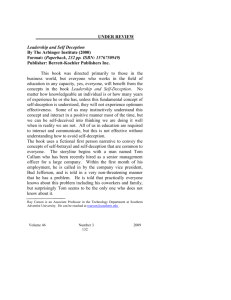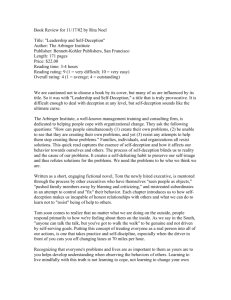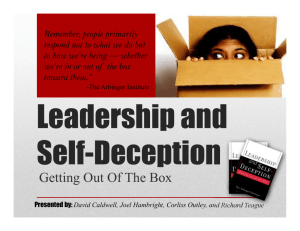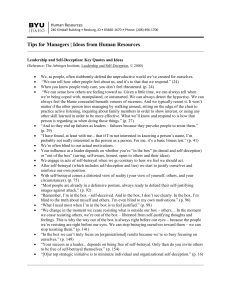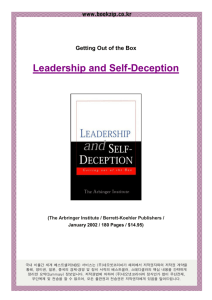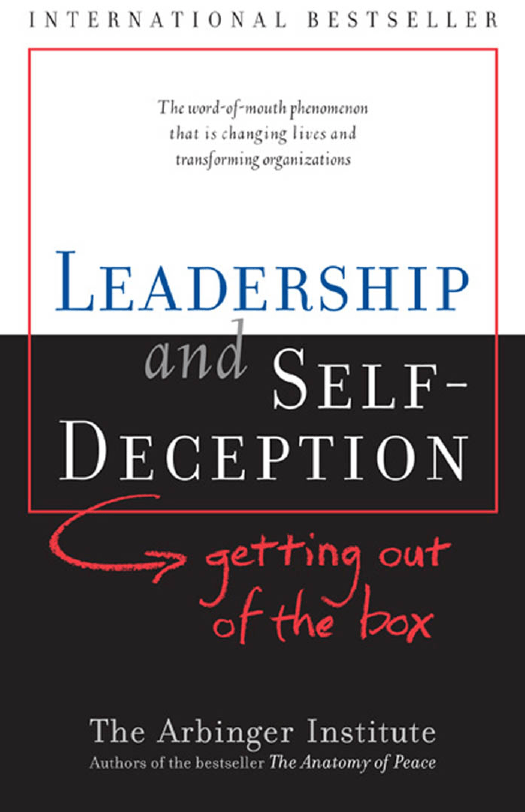
an excerpt from
Leadership and Self-Deception:
Getting Out of the Box
by The Arbinger Institute
Published by Berrett-Koehler Publishers
Contents
Preface . . . . . . . . . . . . . . . . . . . . . . . . . . . . . . . . . . . . . . . . . . . . . vii
Part I Self-Deception and the “Box”
1
2
3
4
5
6
7
8
Bud . . . . . . . . . . . . . . . . . . . . . . . . . . . . . . . . . . . . . . . . . 3
A Problem . . . . . . . . . . . . . . . . . . . . . . . . . . . . . . . . . . . . 7
Self-Deception. . . . . . . . . . . . . . . . . . . . . . . . . . . . . . . . 10
The Problem beneath Other Problems . . . . . . . . . . . . 17
Beneath Effective Leadership . . . . . . . . . . . . . . . . . . . . 21
The Deep Choice That Determines Influence . . . . . . 31
People or Objects . . . . . . . . . . . . . . . . . . . . . . . . . . . . . 41
Doubt. . . . . . . . . . . . . . . . . . . . . . . . . . . . . . . . . . . . . . . 49
Part II How We Get in the Box
9
10
11
12
13
14
15
16
Kate . . . . . . . . . . . . . . . . . . . . . . . . . . . . . . . . . . . . . . . . 57
Questions . . . . . . . . . . . . . . . . . . . . . . . . . . . . . . . . . . . . 61
Self-Betrayal. . . . . . . . . . . . . . . . . . . . . . . . . . . . . . . . . . 64
Characteristics of Self-Betrayal . . . . . . . . . . . . . . . . . . . 72
Life in the Box . . . . . . . . . . . . . . . . . . . . . . . . . . . . . . . . 81
Collusion . . . . . . . . . . . . . . . . . . . . . . . . . . . . . . . . . . . . 91
Box Focus. . . . . . . . . . . . . . . . . . . . . . . . . . . . . . . . . . . 104
Box Problems. . . . . . . . . . . . . . . . . . . . . . . . . . . . . . . . 108
Part III How We Get out of the Box
17
18
19
20
21
22
23
24
Lou. . . . . . . . . . . . . . . . . . . . . . . . . . . . . . . . . . . . . . . . 117
Leadership in the Box . . . . . . . . . . . . . . . . . . . . . . . . . 121
Toward Being out of the Box . . . . . . . . . . . . . . . . . . . . 126
Dead Ends . . . . . . . . . . . . . . . . . . . . . . . . . . . . . . . . . . 129
The Way Out . . . . . . . . . . . . . . . . . . . . . . . . . . . . . . . . 140
Leadership out of the Box . . . . . . . . . . . . . . . . . . . . . . 149
Birth of a Leader . . . . . . . . . . . . . . . . . . . . . . . . . . . . . 159
Another Chance . . . . . . . . . . . . . . . . . . . . . . . . . . . . . 163
Index. . . . . . . . . . . . . . . . . . . . . . . . . . . . . . . . . . . . . . . . . . . . . . 169
About THE ARBINGER INSTITUTE . . . . . . . . . . . . . . . . . . . . . . . . 175
v
Preface
For too long, the issue of self-deception has been the realm of
deep-thinking philosophers, academics, and scholars working on the central questions of the human sciences. The public remains generally unaware of the issue. That would be
fine except that self-deception is so pervasive it touches every
aspect of life. “Touches” is perhaps too gentle a word to
describe its influence. Self-deception actually determines
one’s experience in every aspect of life. The extent to which
it does that, and in particular the extent to which it is the central issue in personal and professional leadership, is the subject of this book.
To give you an idea of what’s at stake, consider the following analogy. An infant is learning to crawl. She begins by
pushing herself backward around the house. Backing herself
around, she gets lodged beneath the furniture. There she
thrashes about—crying and banging her little head against
the sides and undersides of the pieces. She is stuck and hates
it. So she does the only thing she can think of to get herself
out—she pushes even harder, which only worsens her problem. She’s more stuck than ever.
If this infant could talk, she would blame the furniture for
her troubles. She, after all, is doing everything she can think
of. The problem couldn’t be hers. But of course, the problem
is hers, even though she can’t see it. While it’s true she’s doing
everything she can think of, the problem is precisely that she
can’t see how she’s the problem. Having the problem she has,
nothing she can think of will be a solution.
vii
Leadership and Self-Deception
Self-deception is like this. It blinds us to the true cause of
problems, and once blind, all the “solutions” we can think of
will actually make matters worse. That’s why self-deception is
so central to leadership—because leadership is about making
matters better. To the extent we are self-deceived, our leadership is undermined at every turn, and not because of the
furniture.
We have written this book to educate people about this
most central of problems, a problem that has been the exclusive terrain of scholars for far too long. But this book is about
more than the problem—it offers a solution to self-deception
as well.
Our experience in teaching about self-deception and its
solution is that people find this knowledge liberating. It
sharpens vision, reduces feelings of conflict, enlivens the
desire for teamwork, redoubles accountability, magnifies the
capacity to achieve results, and deepens satisfaction and happiness. This is true whether we are sharing these ideas with
corporate executives in New York, governmental leaders in
London, community activists in Malaysia, or parenting
groups in Japan. Members of every culture participate to
one degree or another in their own individual and cultural
self-deceptions. The discovery of a way out of those selfdeceptions is the discovery of hope and the birth of new possibilities and lasting solutions.
This book was first published in the year 2000, with
the paperback appearing in 2002. The ideas about selfdeception, told as they are through a fictional story that captures most readers, has made Leadership and Self-Deception
a prominent international bestseller that is now available in
over twenty languages. Our most recent bestseller, The
Anatomy of Peace, published in 2006, builds on both the story
viii
P r e fa c e
and the ideas developed in Leadership and Self-Deception.
Individually and together, these books help readers to see
their work lives and home situations in entirely new ways and
to discover practical and powerful solutions to problems they
were sure were someone else’s.
We hope that this introduction to the self-deception
problem and solution will give people new leverage in their
professional and personal lives—leverage to see themselves
and others differently and therefore leverage to solve what has
resisted solution and to improve what can yet be improved.
In organizations as varied as commercial ventures, neighborhoods, and families, what is needed most is people not just
with influence but with influence for good.
A Note about the Book
Although based on actual experiences in our work with organizations, no character or organization described in this book
represents any specific person or organization. However, the
information that appears about Ignaz Semmelweis is an
actual historical account drawn from the book Childbed
Fever: A Scientific Biography of Ignaz Semmelweis, by K.
Codell Carter and Barbara R. Carter (Westport, CT:
Greenwood Press, 1994.)
ix
PART I
Self-Deception
and the “Box”
1
Bud
It was two months ago to the day that I first entered the
secluded campus-style headquarters of Zagrum Company to
interview for a senior management position. I’d been watching the company for more than a decade from my perch at
one of its competitors and had tired of finishing second. After
eight interviews and a three-week period of silence and selfdoubt, I was hired to lead one of Zagrum’s product lines.
I was about to be introduced to a senior management ritual peculiar to Zagrum—a day-long, one-on-one meeting
with the executive vice president, Bud Jefferson. Bud was
right-hand man to Zagrum’s president, Kate Stenarude. And
due to a shift within the executive team, he was about to
become my new boss.
I had tried to find out what this meeting was all about, but
my colleagues’ explanations confused me. They mentioned
a discovery that solves “people problems,” how no one really
focuses on results, and that something about the “Bud
Meeting,” as it was called, and strategies that evidently follow
from it, is key to Zagrum’s incredible success. I had no idea
what they were talking about, but I was eager to meet, and
impress, my new boss.
I knew Bud by reputation only. He had been present at a
product rollout conference I attended but had taken no active
part. He was a youngish-looking 50-year-old combination of
odd-fitting characteristics: a wealthy man who drove around
in an economy car without hubcaps; a near high-school
dropout who graduated with law and business degrees, summa
cum laude, from Harvard; a connoisseur of the arts who was
3
Self-Deception and the “Box”
hooked on the Beatles. Despite his apparent contradictions,
and perhaps partly because of them, Bud was revered as
something of an icon in the company—like Zagrum, mysterious yet open, driven yet humane, polished yet real. He was
universally admired, if wondered about, in the company.
It took 10 minutes on foot to cover the distance from my
office in Building 8 to the lobby of the Central Building. The
pathway—one of 23 connecting Zagrum’s 10 buildings—
meandered beneath oak and maple canopies along the banks
of Kate’s Creek, a postcard-perfect manmade stream that was
the brainchild of Kate Stenarude and named after her by the
employees.
As I scaled the Central Building’s hanging steel stairway
up to the third floor, I reviewed my performance during my
month at Zagrum: I was always among the earliest to arrive
and latest to leave. I felt that I was focused and didn’t let outside matters interfere with my objectives. Although my wife
often complained of it, I was making a point to outwork and
outshine every coworker who might compete for promotions
in the coming years. I had nothing to be ashamed of. I was
ready to meet Bud Jefferson.
Arriving in the main lobby of the third floor, I was greeted
by Bud’s secretary, Maria. “You must be Tom Callum,” she
said with enthusiasm.
“Yes, thank you. I have an appointment with Bud for
9:00,” I said.
“Yes. Bud asked me to have you wait for him in the
Eastview Room. He should be with you in about five minutes.” Maria escorted me down the hall and left me to myself
in a large conference room, where from the long bank of windows I admired the views of the campus between the leaves
4
Bud
of the green Connecticut wood. A minute or so later there
was a brisk knock on the door and in walked Bud.
“Hello, Tom. Thanks for coming,” he said with a big
smile as he offered me his hand. “Please, sit down. Can I get
something for you to drink? Coffee, juice?”
“No, thank you,” I replied, “I’ve had plenty already this
morning.”
I settled in the black leather chair nearest me, my back to
the window, and waited for Bud as he poured himself some
water out of the pitcher in the serving area in the corner. He
walked back with his water, bringing the pitcher and an extra
glass with him. He set them on the table between us.
“Sometimes things can get pretty hot in here. We have a lot
to do this morning. Please, feel free whenever you’d like.”
“Thanks,” I stammered. I was grateful for the gesture but
more unsure than ever what this was all about.
“Tom,” said Bud abruptly, “I’ve asked you to come today
for one reason—an important reason.”
“Okay,” I said evenly, trying to mask the anxiety I was
feeling.
“You have a problem—a problem you’re going to have to
solve if you’re going to make it at Zagrum.”
I felt as if I’d been kicked in the stomach. I groped for
some appropriate word or sound, but my mind was racing
and words failed me. I was immediately conscious of the
pounding of my heart and the sensation of blood draining
from my face.
As successful as I had been in my career, one of my hidden weaknesses was that I was too easily knocked off balance.
I had learned to compensate by training the muscles in my
face and eyes to relax so that no sudden twitch would betray
my alarm. And now, it was as if my face instinctively knew
5
Self-Deception and the “Box”
that it had to detach itself from my heart or I would be found
out to be the same cowering third-grader who broke into an
anxious sweat, hoping for a “well done” sticker, every time
Mrs. Lee passed back the homework.
Finally I managed to say, “A problem? What do you
mean?”
“Do you really want to know?” asked Bud.
“I’m not sure. I guess I need to from the sound of it.”
“Yes,” Bud agreed, “you do.”
6
2
A Problem
“You have a problem,” Bud continued. “The people at work
know it; your spouse knows it; your mother-in-law knows it. I
bet even your neighbors know it.” He was smiling warmly.
“The problem is that you don’t know it.”
I found myself speechless. How could I know I had a
problem if I didn’t even know what the problem was?
“I’m afraid I don’t know what you mean. Are you saying
that I . . . that I. . . .” I had no idea what he was talking about.
“Well,” he said in a way that made me think he was enjoying this, “think about these examples for starters.
“Remember the time you had a chance to fill the car with
gas before your wife took it, but then you decided she could
fill it just as easily as you, so you took the car home empty?”
How did he know about that? I wondered.
“Or the time you promised the kids a trip to the ballpark
but backed out at the last minute, on some feeble excuse,
because something more appealing had come up?”
How did he know about that?
“Or the time, under similar circumstances, you took the
kids to the ball game anyway but made them feel guilty for it?”
Uh-oh.
“Or the time, when reading to your toddler, you cheated
him by turning more than one page at a time because you
were impatient and ‘he wouldn’t notice anyway’?”
Yeah, but he didn’t notice.
“Or the time you parked in a Handicapped Only parking
zone and then faked a limp so people wouldn’t think you
were a total jerk?”
7
Self-Deception and the “Box”
Hah! I’ve never done that.
“Or the time you did the same thing but ran from the car
with apparent purpose to show that your errand was so important that you just had to park there?”
Well, I have to admit I have done that.
“Or the time, driving at night, the driver of a car close
behind you kept his brights on, and you let him pass so you
could do the same thing back to him?”
So?
“And think of your style at work,” he continued, now on
a roll. “Do you sometimes demean others? Are you sometimes punishing and disdainful toward the people around
you, scornful of their laziness and incompetence?”
“I guess that’s true part of the time,” I muttered. I had to
admit it; he seemed to know. “But—”
“Or do you more often try to do the acceptable thing?”
he interrupted. “Do you indulge the people who report to you
with kindness and all the other ‘soft stuff’ you can think of in
order to get them to do what you want—even though you still
feel basically scornful toward them?”
This was hitting below the belt. “I work hard at treating
my people right,” I protested.
“I’m sure you do,” he said. “But let me ask you a question.
How do you feel when you’re ‘treating them right,’ as you say?
Is it any different from the way you feel when you’re being
punishing and scornful toward people? Deep down, is there
any difference?”
“I’m not sure I know what you mean,” I replied, stalling
for time.
“I mean this: Do you feel you have to ‘put up’ with people? Do you feel—honestly, now—that you have to work
8
A Problem
pretty hard to succeed as a manager when you’re stuck with
the kind of people you’re stuck with?”
“Stuck?” I asked, still stalling.
“Think about it. You know what I mean,” he said, still
smiling.
I thought frantically. There was no escape. Finally, I
replied: “Well, I guess it’s true. I do think a lot of people are
lazy and incompetent. But what am I supposed to do? Telling
them doesn’t usually help. So I try to get them going in other
ways. Some I cajole, others I try to motivate, others I outsmart,
and so on. And I try to smile a lot. I’m kind of proud of how I
handle myself, actually.”
Bud smiled kindly. “I understand. But when we’re finished, you won’t be so proud of it. What you’re doing is often
wrong.”
I was incredulous. “How can it be wrong to treat people
right?”
“But you’re not treating them right. That’s the problem.
And you’re doing more damage than you know.”
“What do you mean? You’re going to have to explain that
to me.” Angry now, as well as befuddled, I wanted to know
what he was up to.
“I’ll be happy to explain it to you,” he said calmly. “I can
help you learn what your problem is—and what to do about
it. That’s why we’re meeting.” He paused and then added, “I
can help you because I have the same problem.”
Bud rose from his chair—slowly, even solemnly—and
began pacing the length of the table. “To begin with, you need
to know about a problem at the heart of the human sciences.”
9
3
Self-Deception
“You have kids, don’t you, Tom?”
I was grateful for the simple question and felt the life
come back to my face. “Why, yes, one actually. His name is
Todd. He’s 16.”
“You remember how you felt when he was born—how it
seemed to change your perspective on life?” Bud asked.
It had been a long while since I considered those early
thoughts surrounding Todd’s birth. So much had happened
since then that those memories had been swept downstream
by a decade of bitter words and memories. Todd had been
diagnosed as having attention deficit disorder (ADD), and it
was impossible for me to think of Todd without feeling a disturbance in my soul. He was nothing but trouble and had
been for years. But Bud’s question called me back to a sweeter
time. “Yes, I remember,” I began pensively. “I remember
holding him close, pondering my hope for his life—feeling
inadequate, even overwhelmed, but at the same time grateful.” The memory lessened for a moment the pain I felt in the
present.
“That was the way it was for me too,” Bud said, nodding
his head knowingly. “I want to tell you a story that began with
the birth of my first child. His name is David.
“I was a young lawyer at the time, working long hours at
one of the most prestigious firms in the country. One of the
deals I worked on was a major financing project that involved
about 30 banks worldwide. Our client was the lead lender on
the deal.
10
Self-Deception
“It was a complicated project involving many lawyers. In
our firm alone, there were eight attorneys assigned to it from
four different offices worldwide. I was the second most junior
member of the team and had chief responsibility for the drafting of 50 or so agreements that sat underneath the major
lending contract. It was a big, sexy deal involving international travel, numbers with lots of zeros, and high-profile
characters.
“A week after I’d been assigned to the project, Nancy and
I found out she was pregnant. It was a marvelous time for us.
David was born some eight months later, on December 16.
Before the birth I worked hard to wrap up or assign my projects so that I could take three weeks off with our new baby. I
don’t think I’ve ever been happier in my life.
“But then came a phone call. It was December 29. The
lead partner on the deal was calling me. I was needed at an
‘all-hands’ meeting in San Francisco.
“ ‘How long?’ I asked.
“ ‘Until the deal closes—could be three weeks, could be
three months. We’re here until it’s done,’ he said.
“I was crushed. The thought of leaving Nancy and David
alone in our Alexandria, Virginia, home left me desperately
sad. It took me two days to wrap up my affairs in D.C. before
I reluctantly boarded a plane for San Francisco. I left my
young family at the curb at what used to be called National
Airport. With a photo album under my arm, I tore myself away
from them and turned through the doors of the terminal.
“By the time I arrived at our San Francisco offices, I was
the last one in on the deal. Even the guy from our London
office beat me. I settled into the last remaining guest office—
an office on the 21st floor. The deal headquarters, and everyone else, was on floor 25.
11
Self-Deception and the “Box”
“I hunkered down and got to work. Most of the action was
on 25—meetings, negotiations among all the parties, everything. But I was alone on 21—alone with my work and my
photo album, which sat opened on my desk.
“I worked from 7:00 A.M. till after 1:00 A.M. every day.
Three times a day I would go down to the deli in the lobby
and purchase a bagel, a sandwich, or a salad. Then I’d go back
up to 21 and eat while poring over the documents.
“If you had asked me at the time what my objective was,
I would have told you that I was ‘drafting the best possible
documents to protect our client and close the deal,’ or something to that effect. But you should know a couple of other
things about my experience in San Francisco.
“All of the negotiations that were central to the documents I was working on were happening on the 25th floor.
These 25th-floor negotiations should have been very important to me because every change to the deal had to be
accounted for in all the documents I was drafting. But I didn’t
go up to 25 much.
“In fact, after 10 days of lobby deli food, I found out that
food was being served around the clock in the main conference room on 25 for everyone working on the deal. I was
upset that no one had told me about it. And twice during
those 10 days I was chewed out for failing to incorporate some
of the latest changes into my documents. No one had told me
about those either! Another time I was chewed out for being
hard to find. And on two occasions during that period, the
lead partner asked for my opinion on issues that had never
occurred to me—issues that would have occurred to me had
I been thinking. They were in my area of responsibility. He
shouldn’t have had to do my job for me.”
At this, Bud sat back down.
12
Self-Deception
“Now, let me ask you a question, Tom. Just from the little bit you now know about my San Francisco experience,
would you say that I was really committed to ‘drafting the best
possible documents to protect our client and close the deal’?”
“No, I don’t think so,” I said, surprised at the ease with
which I was about to lampoon Bud Jefferson. “In fact, you
don’t seem like you were engaged in the project at all. You
were preoccupied with something else.”
“That’s right,” he agreed. “I wasn’t engaged in it. And do
you think the lead partner could tell?”
“I think after those 10 days it would have been obvious,”
I offered.
“He could tell well enough to chew me out a couple of
times at the very least,” Bud agreed. “How about this: Do you
suppose he would say that I’d bought into the vision? Or that
I was committed? Or that I was being maximally helpful to
others on the deal?”
“No, I don’t think so. By keeping yourself isolated you
were putting things at risk—his things,” I answered.
“I think you’re right,” Bud agreed. “I had become a problem. I wasn’t engaged in the deal, wasn’t committed, hadn’t
caught the vision, was making trouble for others, and so on.
But consider this: How do you suppose I would have
responded had someone accused me of not being committed or not being engaged? Do you think I would have agreed
with them?”
I pondered the question. Although it should have been
outwardly obvious, Bud might have had trouble seeing himself as others saw him at the time. “No. I suspect you might
have felt defensive if someone had said that to you.”
“You’re right. Think about it: Who left behind a new baby
to come to San Francisco? I did,” he said, answering his own
13
Self-Deception and the “Box”
question. “And who was working 20-hour days? I was.” Bud
was becoming more animated. “And who was forced to work
alone four floors below the others? I was. And to whom did
people even forget to mention basic details like food plans?
To me. So from my perspective, who was making things difficult for whom?”
“I guess you would have seen others as being the main
cause of the trouble,” I answered.
“You better believe it,” he agreed. “And how about being
committed, engaged, and catching the vision? Do you see
that from my perspective, not only was I committed, I just
might’ve been the most committed person on the deal? For
from my perspective, no one had as many challenges to deal
with as I had. And I was working hard in spite of them.”
“That’s right,” I said, relaxing back into my chair and nodding affirmatively. “You would have felt that way.”
“Now, think about it, Tom.” Bud was standing again and
began pacing the floor. “Remember the problem. I was
uncommitted, disengaged, hadn’t caught the vision, and was
making things more difficult for others on the deal. That’s all
true. And that’s a problem—a big problem. But there was a
bigger problem—and it’s this problem that you and I need to
talk about.”
He had my full attention.
“The bigger problem was that I couldn’t see that I had a
problem.”
Bud paused for a moment, and then, leaning forward
toward me, he said in a lower, even more earnest tone,
“There is no solution to the problem of lack of commitment,
for example, without a solution to the bigger problem—the
problem that I can’t see that I’m not committed.”
14
Self-Deception
I suddenly started to feel uneasy and could feel my face
again sag to expressionlessness. I had been caught up in Bud’s
story and had forgotten that he was telling it to me for a reason. This story was for me. He must be thinking that I have a
bigger problem. My mind was starting to race with self-worry
when I heard Bud’s voice again.
“Tom, there’s a technical name for the insistent blindness I exhibited in San Francisco. Philosophers call it ‘selfdeception.’ At Zagrum we have a less technical name for it—
we call it ‘being in the box.’ In our way of talking, when we’re
self-deceived, we’re ‘in the box.’
“You’re going to learn a lot more about the box, but as a
starting point, think of it this way: In one sense, I was ‘stuck’
in my experience in San Francisco. I was stuck because I had
a problem I didn’t think I had—a problem I couldn’t see. I
could see matters only from my own closed perspective, and
I was deeply resistant to any suggestion that the truth was otherwise. So I was in a box—cut off, closed up, blind. Does that
make sense?”
“Sure. I get the idea,” I responded, temporarily reconnecting with Bud and his story.
“There’s nothing more common in organizations than
self-deception,” he continued. “For example, think about a
person from your work experience who’s a really big problem—say, someone who’s been a major impediment to
teamwork.”
That was easy—Chuck Staehli, COO of my former
employer. He was a jerk, plain and simple. He thought of no
one but himself. “Yeah, I know such a guy.”
“Well, here’s the question: Does the person you’re thinking of believe he’s a problem like you believe he’s a problem?”
“No. Definitely not.”
15
Self-Deception and the “Box”
“That’s usually the case,” he said, stopping directly across
from me. “Identify someone with a problem and you’ll be
identifying someone who resists the suggestion that he has a
problem. That’s self-deception—the inability to see that one
has a problem. Of all the problems in organizations, it’s the
most common—and the most damaging.”
Bud placed his hands on the back of his chair, leaning
against it. “Remember how a few minutes ago I mentioned
that you needed to know something about a problem in the
human sciences?”
“Yes.”
“This is it. Self-deception—the box—is that problem.”
Bud paused. It was clear this was a point of major importance
to him.
“At Zagrum, Tom, our top strategic initiative is to minimize individual and organizational self-deception. To give
you an idea why it’s so important to us,” he said, starting again
to pace, “I need to tell you about an analogous problem in
medicine.”
16
this material has been excerpted from
Leadership and Self-Deception:
Getting Out of the Box
by The Arbinger Institute
Published by Berrett-Koehler Publishers
Copyright © 2008, All Rights Reserved.
For more information, or to purchase the book,
please visit our website
www.bkconnection.com

